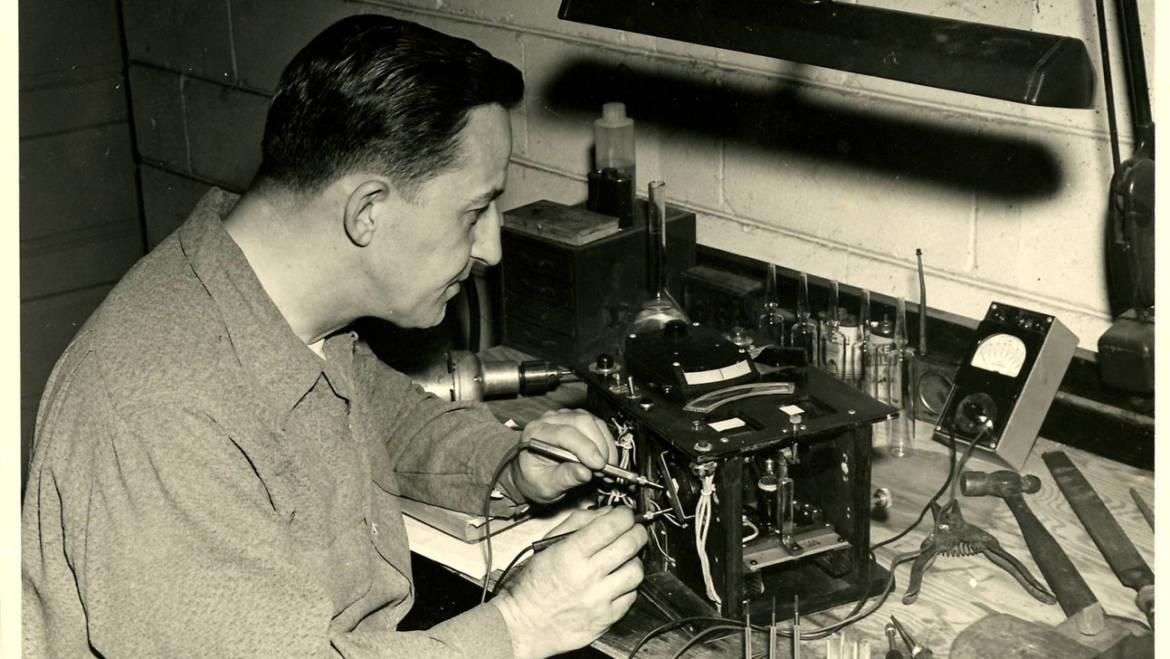On this day one hundred years ago, Robert F. Borkenstein, the inventor of the Breathalyzer and internationally known educator and researcher, was born in Fort Wayne, Indiana. He joined the Indiana State Police becoming a state trooper in 1936 and eventually became captain and director of the Indiana State Police Criminological Laboratory, one of the first police laboratories in the US.
Known to many as “Bob”, he developed a working model of the Breathalyzer in the partially dirt-floored basement of his small Indianapolis home in February 1954 (to see the Breathalyzer patent click here). The Breathalyzer became one of the most successful and widely-used breath alcohol testing instruments used by the police throughout the world. Over 30,000 units were sold between 1955 and 1999, a record in longevity that will almost certainly not be repeated. The Breathalyzer was so widely used by the police that it has almost become a generic name for any breath testing instrument. Bob’s invention has contributed greatly to increased traffic safety over the years and has become an irreplaceable tool of the police.
In 1958, Robert F. Borkenstein retired from the Indiana State Police and started a course at Indiana University in Bloomington on alcohol and traffic safety. The course, now known to many as the “Borkenstein course” or the “Borky”, continues to this day. I took the course in 1985 and the faculty then included many international experts including J.J. Havard from the UK, Robert Forney Sr. and Kurt Dubowski. The Borkenstein course continues to maintain its excellence with faculty like Kurt Dubowski (emeritus), Bob Forney (son of Robert Forney Sr.), Wayne Jones (Sweden), Rod Gullberg, Barry Logan (originally from the UK) and many other well-qualified lecturers (www.borkensteincourse.org). I joined the faculty in 2004 and now teach on the Borkenstein course in May and December of each year. It is a great privilege and honor to teach on the same course that I took over 25 years ago.
Robert F. Borkenstein had a strong connection to the Centre of Forensic Sciences (CFS) in Toronto, where I worked for 29 years. The first scientific paper published about the Breathalyzer was one written by Robert F. Borkenstein and H. Ward Smith in 1961 (WOA30101, WOA30102). H. Ward Smith was the first director of the CFS and he obtained the second Breathalyzer ever built. The Breathalyzer was basically the only breath alcohol instrument used by the police in Canada for nearly 40 years (for a short historical overview of breath testing in Canada click here).
Bob also conducted a ground-breaking study into the effects of alcohol on the risk of a motor vehicle collision called the Grand Rapids Study. By studying the BrACs of over12,000 drivers in the City of Grand Rapids, Michigan between 1962 and 1963 (WOA50501), he developed the Grand Rapids Relative Risk Curve showing the increasing risk of causing a motor vehicle collision with increasing BrAC as shown in the following Table.

His results were confirmed by a recent and more sophisticated study published in 2009 (WOA50503).
The Borkenstein Grand Rapids Study had a major impact on the development of the .08 laws in Canada in 1969. In recognition of Bob’s major contributions to traffic safety in Canada, he was presented with a Special Minister of Justice’s Award from the Rt. Hon. Kim Campbell, Minister of Justice of Canada at Halifax in 1992. This was only one of the numerous awards and honors he received during his lifetime.
Professor Robert F. Borkenstein, LL.D (Hon.), D.Sc (Hon.), A.B., Professor Emeritus at Indiana University died at his home in Bloomington, Indiana on August 10th 2002 after a lengthy illness. Doug Lucas (the second director of CFS) wrote a detailed biography and appreciation of Bob’s life and work (www.borkensteincourse.org/borkenstein_appreciation.pdf)
I invite any of you with reminiscences about Bob and his impact on your career to leave a comment on this blog.





